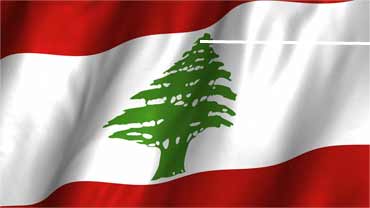
Name: The Lebanese Republic
Flag: Three horizontal bands: Red/ White/ Red. The central white band, twice the width of the red band, has a green cedar in the middle.
Geography: Falls on the Eastern Mediterranean, between 33 degrees and 34.4 degrees latitude north; 35 degrees and 36.40 degrees longitude east.
Area: 10.452 square kilometers. Maritime front on the Mediterranean of 210 km. highest summit is Qornet El Sawda (The Cedars) 3083 meters.
Climate: Mediterranean type , with an average of 300 sunny days a year . Rainfall between 700 and 1200 mm a year, over a period of four months.
Weights/ Measures: Metric system.
Political System: A Parliamentary Democracy The President of the Republic is elected for a non-renewable six-year mandate. The Parliament consists of 128 members, elected by the people for four years. The Executive power is exercised by a Council of Ministers (the Government) headed by the Prime Minister (President of the Council of Ministers).
Population: 3,500,000 inhabitants (estimated). Urban population 80%.
Structure of National Product:
Agriculture 10%
Industry and Construction 20%
Trade and Services 70%
Spoken Languages: Arabic, French, English and Armenian.
Exchange: A Free Market Exchange System.
Currency: Lebanese Lira.
1560 = US $1/Sept 96
Structure: Lebanon is divided into 6 Mohafazats (Governorates):
- Beirut
- Mont Lebanon - county town Baabda
- North Lebanon - county town Tripoli
- South Lebanon - county town Sidon
- Beqaa - county town Zahleh
- Nabatieh - county town Nabatieh
The Mohafazats are subdivided into Cazas. The people of each city or village elect a Municipal Council and a Mayor by a direct voting system.
Bordered on one side by the Mediterranean and on the other by two parallel mountain ranges, Lebanon seems a country suspended between the sky and the sea. Despite its small area (10.452 square km), it is a land resplendent in its diverse geography, landscape, culture and history.
From the white - capped blue sea, to the countryside, from arid hills to lush forests, the visitor discovers a series of contrasts. Bare Rocky Mountains are followed by luxuriant valleys watered by rivers and waterfalls. Scenery change quickly from pine covered hills to dramatic rocky landscapes, to fertile plains laid out with farms and vineyards.
Lebanon is also a country of multiple origins shaped by 10.000 years of history. From earliest times its natural beauty and privileged geographical position attracted conquerors and occupiers who left behind traces of their civilizations. Each added an indelible imprint to the makeup of what would become modern Lebanon.
The legacy of the past is clear from the extraordinary variety of archaeological sites in every corner of the country. From Phoenician sarcophagi to Roman temples, to Crusader castles and Mamlouk mosques, wherever you go, evidence of this country's rich and tormented comes to light.
The cuisine of Lebanon, like its culture is surprising in its diversity. It is known above all for its mezze, countless dishes of savory hors-d'oeuvres which are endlessly replenished are served in warm and congenial settings.
Any attempt to describe Lebanon is a task carried out in vain. It cannot be confined by words; it must be lived. So we invite you to visit our marvelous country, where roads lead to and from town to village and from site to city, from one époque to another.








